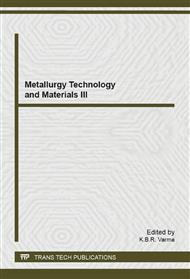p.88
p.92
p.96
p.101
p.105
p.112
p.116
p.125
p.129
Dynamics of Phase Transformation in Cu-Ni-Be Wedge Copper Alloy
Abstract:
This paper aims at doing research on the variation of volume fraction of precipitation. And Avrami empirical equation characterizing the relationship between transformation ratios and ageing time is established. This research was carried out by measuring the electric conductivity of Cu-Ni-Be wedge copper alloy after ageing treatment, and analyzing the relationship between electric conductivity and volume fraction of precipitations. Consequently, the equation between electric conductivity and the ageing time is fixed. Then S-curves of the dynamics of phase dynamics of phase transformation and C-curves of isothermal transformation for the Cu-Ni-Be wedge copper alloy are derived.
Info:
Periodical:
Pages:
105-111
Citation:
Online since:
June 2014
Authors:
Price:
Сopyright:
© 2014 Trans Tech Publications Ltd. All Rights Reserved
Share:
Citation:


